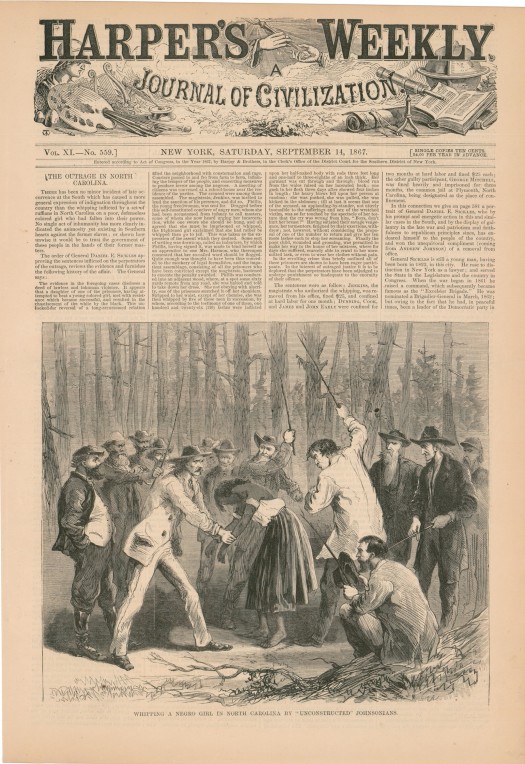“The Outrage in North Carolina:” The Savage Brutalization of Phillis
When I was creating the No Selves to Defend exhibition last year, I knew that it would have two anchors: the stories of Celia and of Marissa Alexander. As I began to conceptualize a new exhibition about Black women and state violence (with several friends), I remembered the story of Phillis, a newly emancipated young Black woman. I knew that she would be an anchor of ‘Blood at the Root.’
Harper’s Weekly described how Phillis was brutally and savagely beaten by a group of men in North Carolina in 1867.
Below is an excerpt from the Harper’s story tiled “The Outrage in North Carolina.” TW: It is very difficult to read.
“There has been no minor incident of late occurrence at the South which has caused a more general expression of indignation throughout the country than the whipping inflicted by a set of ruffians in North Carolina on a poor, defenseless, colored girl who had fallen into their power. No single act of inhumanity has more clearly indicated the animosity yet existing in Southern hearts against the former slaves; or shown how unwise it would be to trust the government of these people in the hands of their former masters.
The order of General Daniel E. Sickles approving the sentences inflicted on the perpetrators of the outrage, reviews the evidence and furnishes the following history of the affair. The General says:
“The evidence in the foregoing cases discloses a deed of lawless and inhuman violence. It appears that the daughter of one of the prisoners, having attempted to beat a young colored girl, met with resistance which became successful, and resulted in the chastisement of the white by the black. This unlooked-for reversal of a long-accustomed relation filled the neighborhood with consternation and rage. Couriers passed to and fro from farm to farm inflaming the temper of the people, and concerting measures to produce terror among the negroes. A meeting of citizens convened at a school-house near the residence of the parties. The accused were among those assembled. The magistrate, Jenkins, was invited to lend the sanction of his presence, and did so. Phillis, the young freedwoman, was sent for. Dragged before the self-constituted conclave of angry men, whom she had been accustomed since infancy to call masters, some of whom she now heard urging her incarceration, while one swore she should be hung, and all agreed she must be imprisoned and whipped, the frightened girl exclaimed that she had rather be whipped than go to jail. This was taken as the expression of assent which they desired. Some sort of writing was drawn up, called an indenture, by which Phillis having signed it, was made to bind herself as apprentice to one Mrs. Harmon, who thereupon consented that her so-called ward should be flogged. Quite enough was thought to have been thus conceded to the mockery of legal formalities, and the impatient assemblage, consisting of all the prisoners who have been convicted except the magistrate, hastened to execute the penalty awarded.
Phillis was conducted into an adjacent wood, where, at a spot some sixty yards remote from any road, she was halted and told to take down her dress. She not obeying with alacrity, one of the prisoners snatched it off her shoulders. Stripped to her waist, except of her chemise, she was then whipped by five of these men in succession, by whom, according to the testimony of one of them, one hundred and twenty-six (126) lashes were inflicted upon her half-naked body with rods three feet long and one-half to three-eighths of an inch thick. Her garment was cut through and through; blood run from the wales raised on her lacerated back; one gash in her flesh three days after showed four inches in length; the heavy blows fell upon her person at random; she was pushed, she was pulled, she was kicked in the abdomen; till at last it seems that one of the accused, an applauding by-stander, not utterly insensible to the sufferings and the sex of the wretched victim, was so far touched by the spectacle of her torture that the cry was wrung from him: ‘Boys don’t hurt her breast!’
Having satiated their savage vengeance, her tormentors, fatigued by their exertions, withdrew: not, however, without considering the proposal of one of the number to return and give her ten more lashes each to stop her screaming. Finally the poor child, wounded and groaning, was permitted to make her way to the house of her mistress, where for days she suffered, scarcely able to crawl to her unremitted task, or even to wear her clothes without pain.
In the revolting crime thus briefly outlined all of these prisoners are shown to have been eager participants. In the interest of outraged justice it is to be deplored that the perpetrators have been adjudged to undergo punishment so inadequate to the enormity of their offense.”
The sentences were as follow: Jenkins, the magistrate who authorized the whipping, was removed from his office, fined $25, and confined at hard labor for one month; Dunning, Cook and James and John Early were confined for two months at hard labor and fined $25 each; the other guilty participant, George Mitchell, was fined heavily and imprisoned for three months, the common jail at Plymouth, North Carolina, being designated as the place of confinement.
Phillis’s story is remarkable for two reasons: 1. it was published in a popular newspaper; 2. the men who were responsible for her savage assault were actually made accountable in some way.
On Friday, Blood at the Root will open. I hope that you will come out to see the exhibition. You’ll get to see an original copy of the newspaper article about Phyllis and much more. RSVP HERE.

